

Our augmented selves: The promise of wearable computing. By Donald Melanson and Michael Gorman It's been an interesting year for Google's most famous side project.
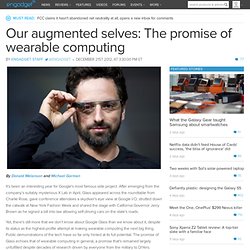
After emerging from the company's suitably mysterious X Lab in April, Glass appeared across the roundtable from Charlie Rose, gave conference attendees a skydiver's eye view at Google I/O, strutted down the catwalk at New York Fashion Week and shared the stage with California Governor Jerry Brown as he signed a bill into law allowing self-driving cars on the state's roads. Yet, there's still more that we don't know about Google Glass than we know about it, despite its status as the highest-profile attempt at making wearable computing the next big thing. Public demonstrations of the tech have so far only hinted at its full potential. The promise of Glass echoes that of wearable computing in general, a promise that's remained largely unfulfilled despite decades of research driven by everyone from the military to DIYers.
The Key Elements Wearables Take Shape. YouTube. PERSONAL HEALTH. Ginger.io. * Wireless Health Trends Trace the Future of Medical Healthcare. Mobile Apps Track Your Weight, Body Fat and Sleep Patterns. Digifit has updated its mobile fitness apps for iOS to integrate with the Withings WiFi Body Scale and Zeo Personal Sleep Coach gadgets to provide users with a single dashboard to monitor their health.
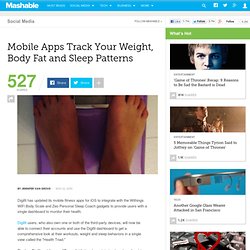
Digifit users, who also own one or both of the third-party devices, will now be able to connect their accounts and use the Digifit dashboard to get a comprehensive look at their workouts, weight and sleep behaviors in a single view called the "Health Triad. " The free Digifit mobile apps [iTunes link] already work to track a slew of metrics, including heart rate and calories burned, for cardio workouts, and can map runs and bike rides. The service is meant to combine the functions of multiple fitness devices — heart rate monitors and run trackers — into a single app experience. Users can purchase additional sensor hardware for more accurate tracking. The Withings WiFi Body Scale is a next-gen scale that records body weight, lean and fat mass and calculates body mass index. Mobile Health Solutions. Wireless sensors and medical technology for mobile lab tests. An enormous, worldwide effort goes into research to detect biological, chemical and physical substances.

All kinds of microscopic devices and technology are being developed to advance mobile healthcare: Identify Viruses, Oligonucleic acids, Peptides, Volatile Organic Compounds and other molecules. Physiological measurements adapt to today's new medical and health technologies. This Is NASA’s Cancer-Sniffing Mobile Phone Sensor. Wireless Bathroom Scales and Other Scary Technology. By Sree Sreenivasan DNAinfo contributing editor There are, broadly speaking, two kinds of new technology.

There are new tech products you understand right away because they improve things you've used for years. Digital music players and electronic readers are examples of this. Then there are new products that you don't understand because you're convinced there's no need for them right now (or that your life is complicated enough without them). AUGMENTED INFORMATION. * Google glass. * Google Project Glass. Google Project Glass releases video with fashion designer Diane von Furstenberg. During New York Fashion Week, acclaimed designer Diane von Furstenberg added a new accessory to her show: Google’s Project Glass.

Today, she released her video made entirely out of Google Glass footage, showing what it’s like to be DVF during the craziest week of fashion in the U.S. The fashion team wore the eyewear created by Google all around DVF’s fashion show, taking video of what they were seeing. Project Glass is a wearable computer that provides information not through a screen, but rather through your “eyes.” It gives you data about your surroundings without the need to whip out your smartphone and know what to search. For example, if you go into a bookstore, Google Glass will be able to provide you with an indoor map of the place, and lead you to your desired book. Layar. Canon overhauls Mixed Reality platform with new head-mounted display. * Canon Mixed Reality Video. June 18, 2012 Canon Inc.
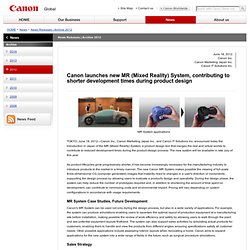
Canon Marketing Japan Inc. Canon IT Solutions Inc. DYNAMIC INFORMATION. Plangrid maakt iPad bruikbaar op de bouwplaats. Tablets @ The Construction Site. The days of carrying around rolls of construction documents on site are in flux.
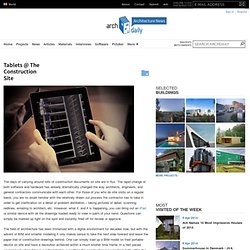
The rapid change of both software and hardware has already dramatically changed the way architects, engineers, and general contractors communicate with each other. For those of you who do site visits on a regular basis, you are no doubt familiar with the relatively drawn out process the contractor has to take in order to get clarification on a detail or problem distillation – taking pictures of detail, scanning redlines, emailing to architect, etc.
However, what if, and it is happening, you can bring out an iPad or similar device with all the drawings loaded ready to view in palm of your hand. Questions can simply be marked up right on the spot and instantly fired off for review or approval. Software currently on the market that address and take advantage of portable tablet devices include Bentley’s Navigator, Autodesk’s AutoCAD WS, PlanGrid, and iRhino 3D (only a viewer at this point). iPad bij Bouwinspectie in Amsterdam is succes. A flexible LG newspaper e-reader. Korean company LG recently unveiled a flexible e-ink display that is about the size of a newspaper.

The 19-inch wide (250x400mm) flexible e-paper is almost as big as a page of A3 sized newspaper. The product is optimized for an e-newspaper and able to convey the feeling of reading an actual newspaper. Additionally, as the product measures 0.3 millimeters thin, the e-paper weighs just 130 grams despite its 19-inch size. LG Display arranged TFT on metal foil rather than glass substrate, allowing the e-paper display to recover its original shape after being bent. Finally, an e-reader you can roll up and stick in your pocket.
Linux e-reader boasts 11.5-inch display. Skiff LLC announced a Linux-based e-book reader optimized for newspaper and magazine content, delivered via Sprint's 3G network. The Skiff Reader's display is claimed to be the largest (11.5 inches) and highest-resolution (UXGA) among e-readers, and the first to offer LG Displays' stainless-steel foil display technology, touted for greater durability. A Hearst Corporation-backed startup formerly known as FirstPaper, Skiff LLC is gambling that consumers will be willing to carry around a larger size e-reader suited to displaying newspaper and magazine content. Due to ship sometime this year, the Skiff Reader is the first of a number of devices that will support the Skiff e-reading service (see farther below). Skiff Reader (Click on either to enlarge) To handle the larger formats required by digital newspapers and magazines, Skiff moves up to an 11.5-inch gray-scale display, along with UXGA (1200 x 1600 pixel) resolution.
The Readius e-reader Lives! A novel ereader, long thought dead, has risen from the grave.
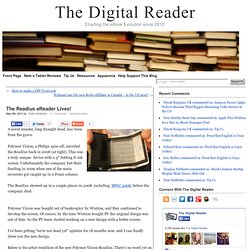
Polymer Vision, a Philips spin-off, unveiled the Readius back in 2008 (at right). This was a truly unique device with a 5″ folding E-ink screen. Unfortunately the company lost their funding in 2009 when one of the main investors got caught up in a Ponzi scheme. The Readius showed up in a couple places in 2008, including MWC 2008, before the company died. The Page: Ultra Thin, Foldable E-Reader Protype. Jae Kim has created a next generation e-reader concept called The Page that is as thin as a sheet of paper, can fold up and has an e-ink screen that can display text and images.
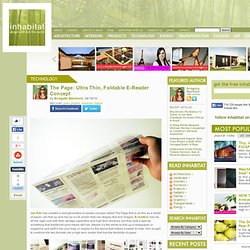
E-readers may be all the rage now with their storage capacities and high-tech wizardry, but they lack a special something that traditional print media still has. Maybe it’s the ability to fold up a newspaper or magazine and stuff it into your bag, or maybe it’s the layout that makes it easier to read. Neurowear wants to read your mind, geotag your feelings (video)
ReQall: Home. Behavio. Sound QR codes offer new advertising possibilities.